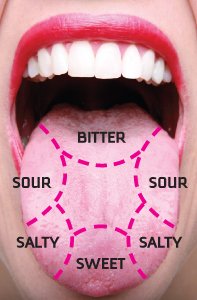Why do some people enjoy the taste of cheeses while others find it sour and aged? Why do some seek out spicy and tangy meals on a restaurant’s menu while others stick with the basic and familiar dishes? New research is uncovering microbiological and genetic sources of taste preferences, which can influence not just eating habits but also our health.
~Taste Buds~
(and how they affect our flavorful decisions.)
When we sit down to devour our favorite meal, we take for granted that we will be able to taste and savor the different flavors in the food. Our sense of taste is so essential to our daily lives that we hardly think about it. But taste, as scientists are discovering, is anything but ordinary. It’s a highly complex neurological process influenced by many factors, including genes, age, and experiences that we've had with food
How sensitive we are to sweetness, bitterness, saltiness or any other taste depends on our genetic makeup. For example, variants of one gene, TAS2R38, help show how strongly an individual will be able to detect something bitter, and may explain why some people have a mighty dislike of broccoli and other vegetables. Research also has shown that some individuals, dubbed “supertasters,” inherit more taste buds and receptor cells than other people. I find everyone actually is at one point depending on the food they are eating. Tastes seem more intense to them and they tend to avoid powerfully flavored foods, including sugary desserts. They typically sometimes use more salt than other people, possibly to block the bitter taste of certain foods.
Taste begins in the mouth, where each of us has between 5,000 and 10,000 taste buds crawling around. Each taste bud contains 50 to 100 taste receptor cells — brain cells called neurons that transmit taste information. When we eat a blueberry, for example, saliva dissolves the fruit’s chemicals; they then enter into the central pores of the taste buds and bind to the taste cells. The cells quickly send “sweet” or “sour” taste messages from these chemicals through nerve fibers to the brain.
 International Cusine in the World
International Cusine in the World



 maryolhoft
maryolhoft